UnifyApps provides a comprehensive experiment framework that enables you to systematically evaluate your AI Agent's performance using predefined datasets and metrics. Experiments allow you to test your agent against multiple scenarios, track performance over time, and identify areas for improvement through both automated metrics and human annotation. Let's explore how to create and manage experiments for thorough agent evaluation.
Understanding Experiments
Experiments are structured evaluation sessions that:
Test your AI Agent against curated datasets
Apply multiple metrics to assess performance
Generate comprehensive reports on agent capabilities
Support both one-time and scheduled recurring evaluations
Enable human review and annotation of results
Create a New Experiment
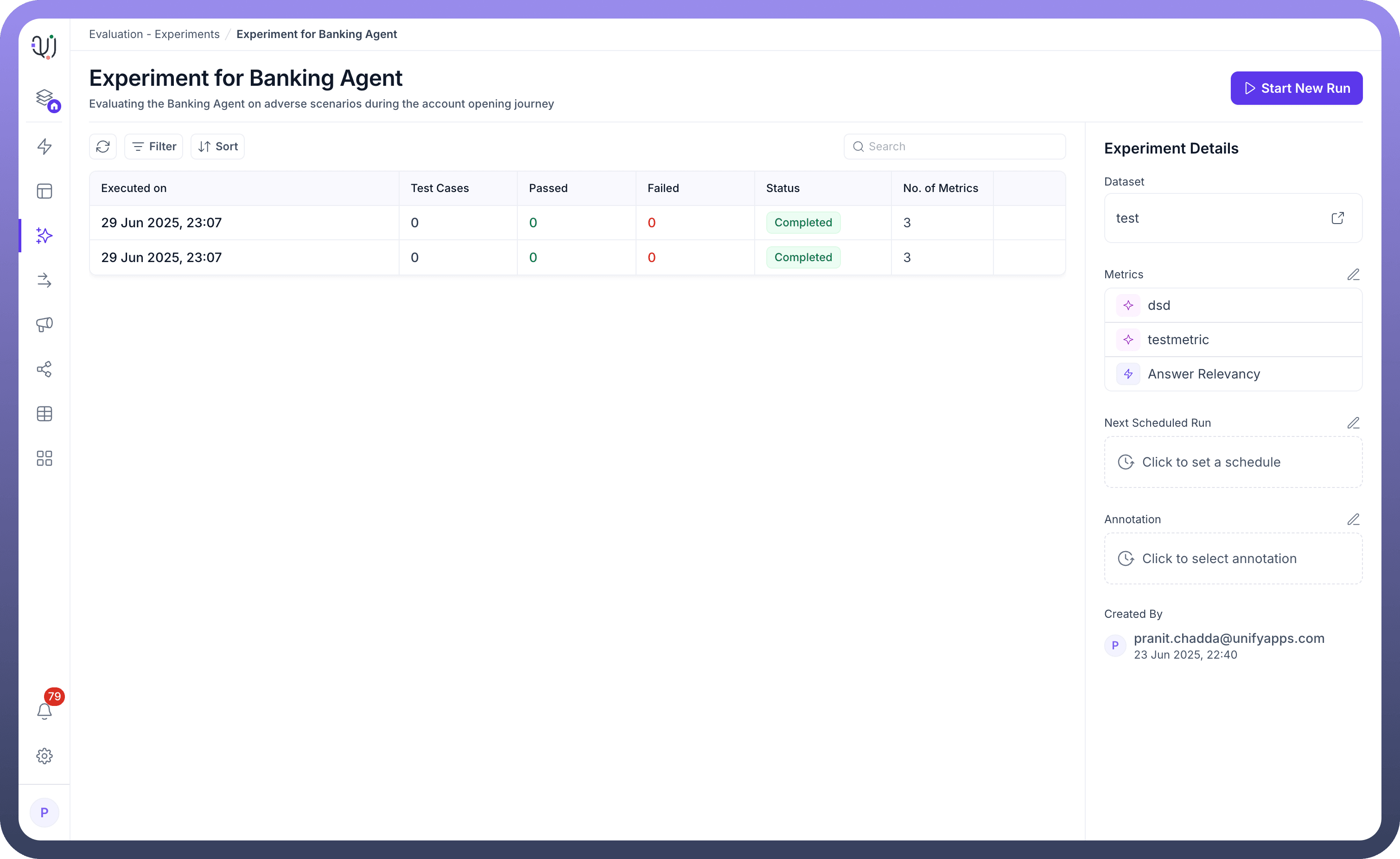
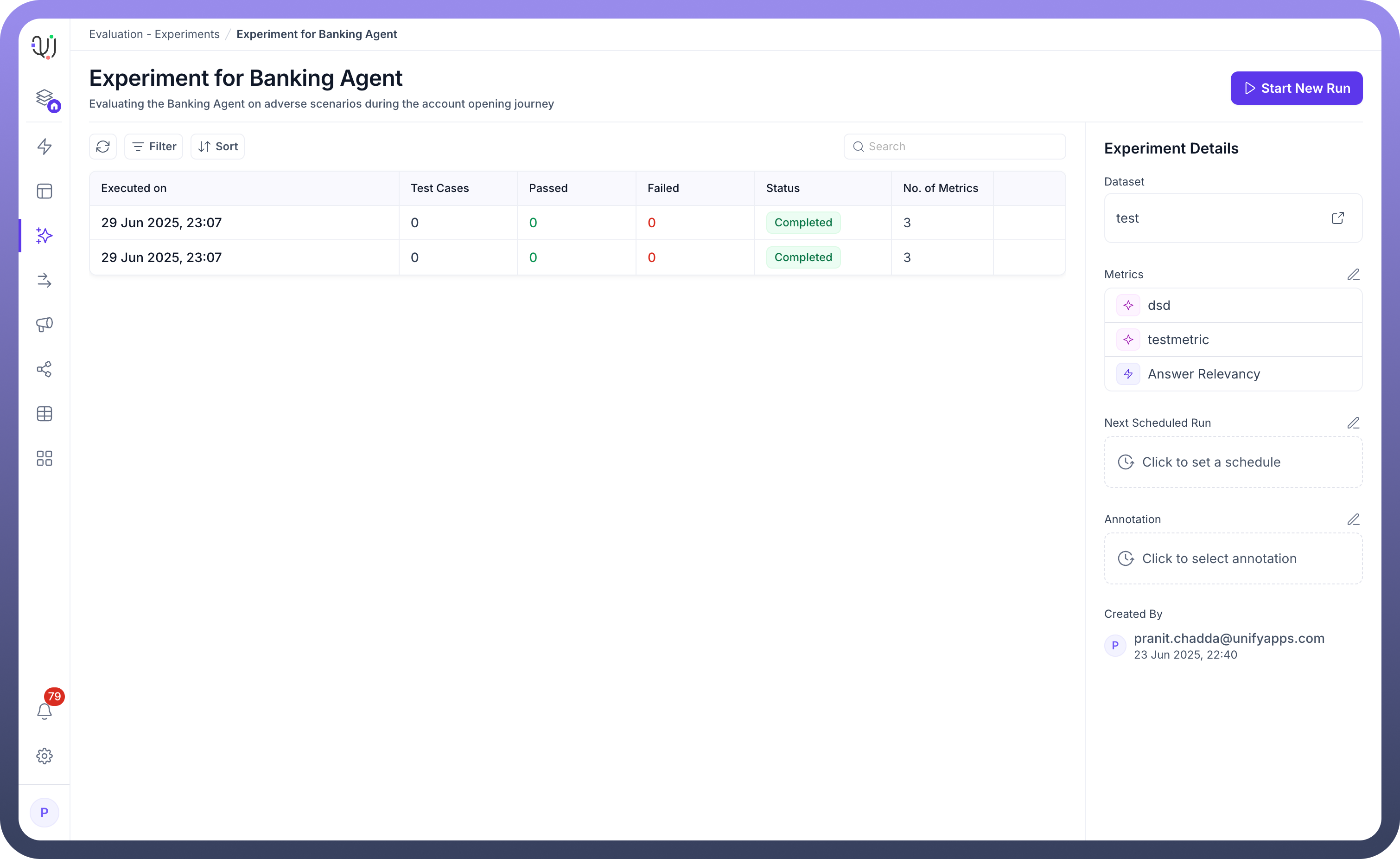
Creating an experiment brings together your datasets, metrics, and evaluation targets into a cohesive testing framework. Here's how to set up comprehensive agent evaluations.

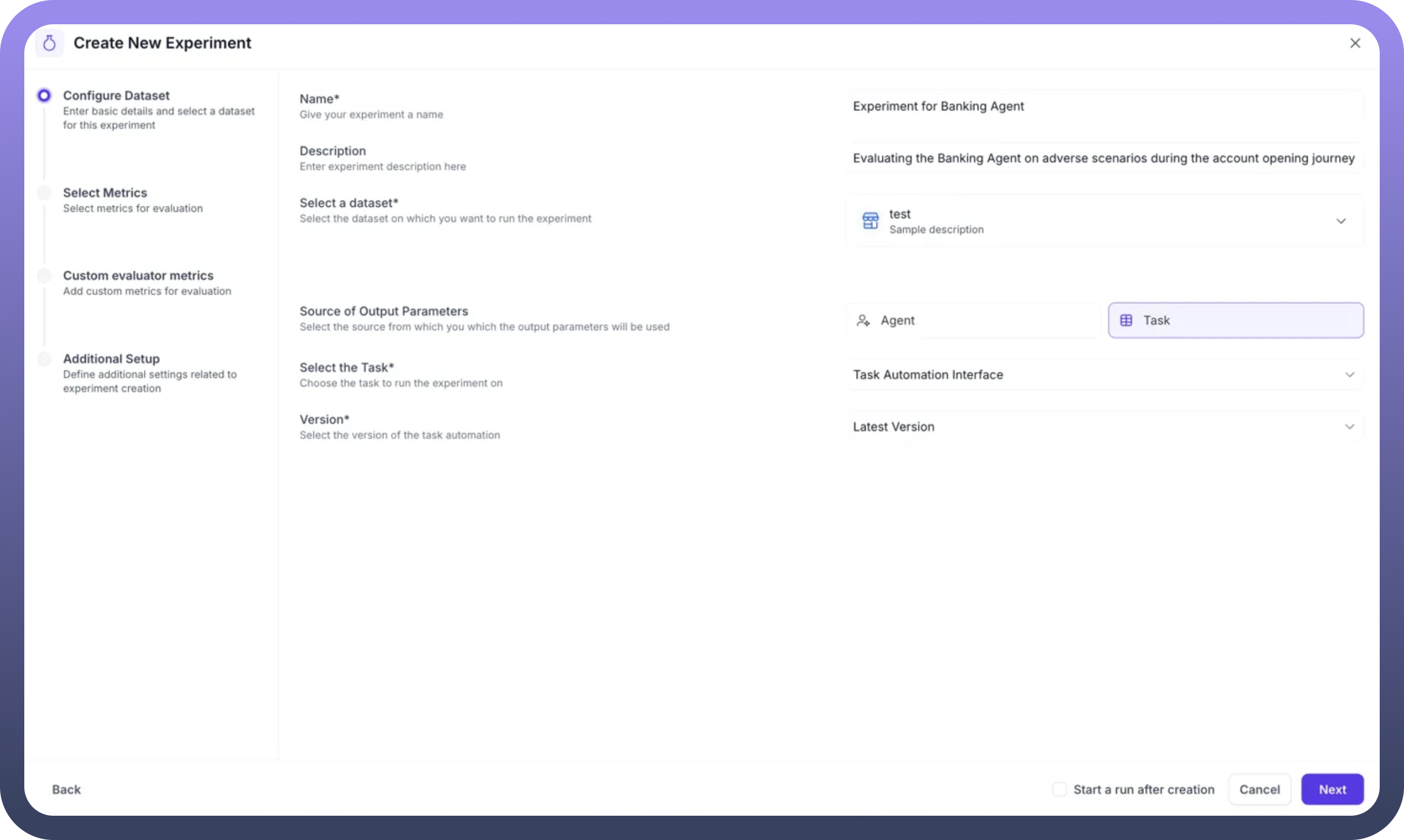
Step 1: Configure Basic Details
Navigate to the Experiments section and click "Create New Experiment" to begin:
Name: Provide a descriptive identifier (e.g., "Experiment for Banking Agent")Description: Document the experiment's purpose and scope (e.g., "Evaluating the Banking Agent on adverse scenarios during the account opening journey")
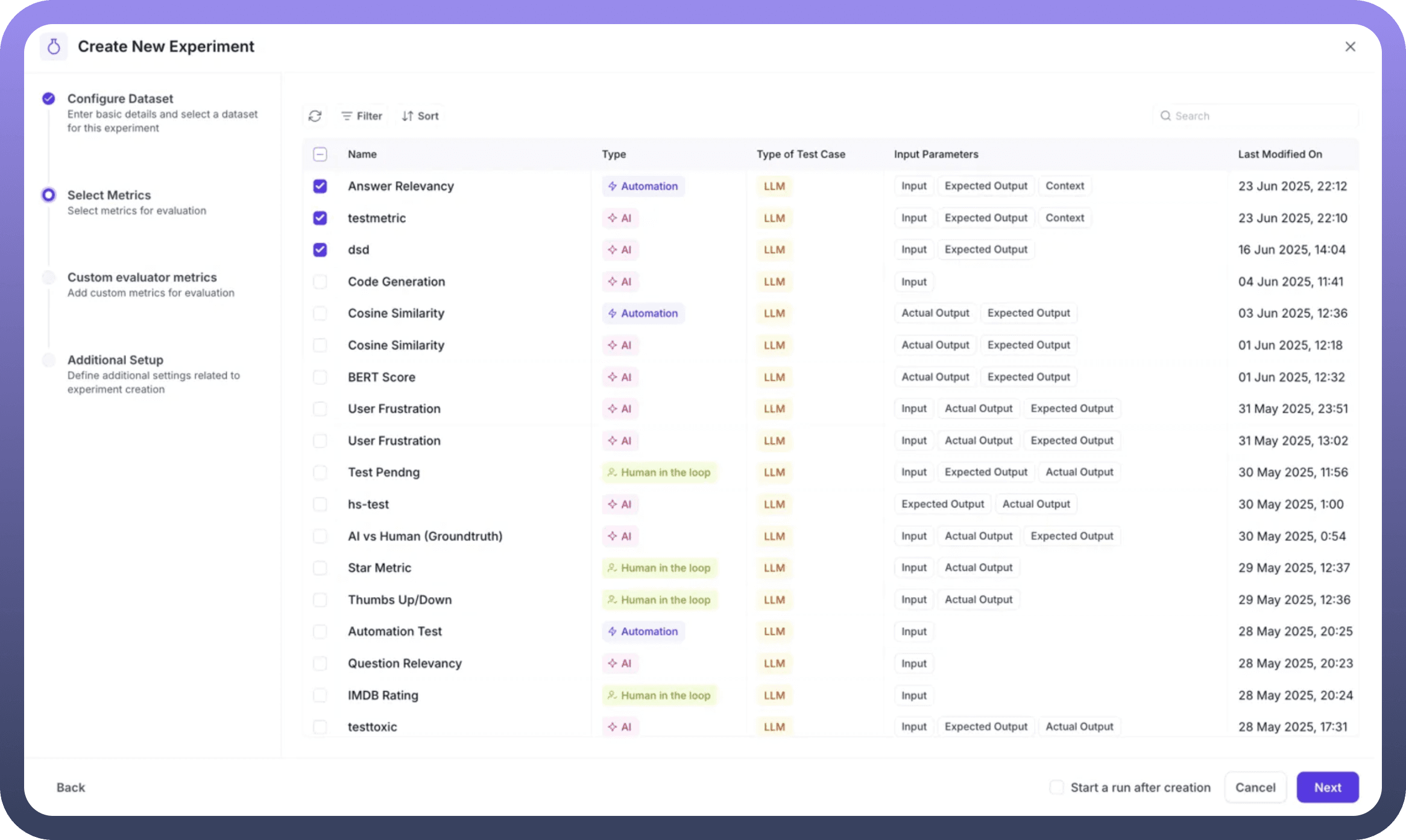
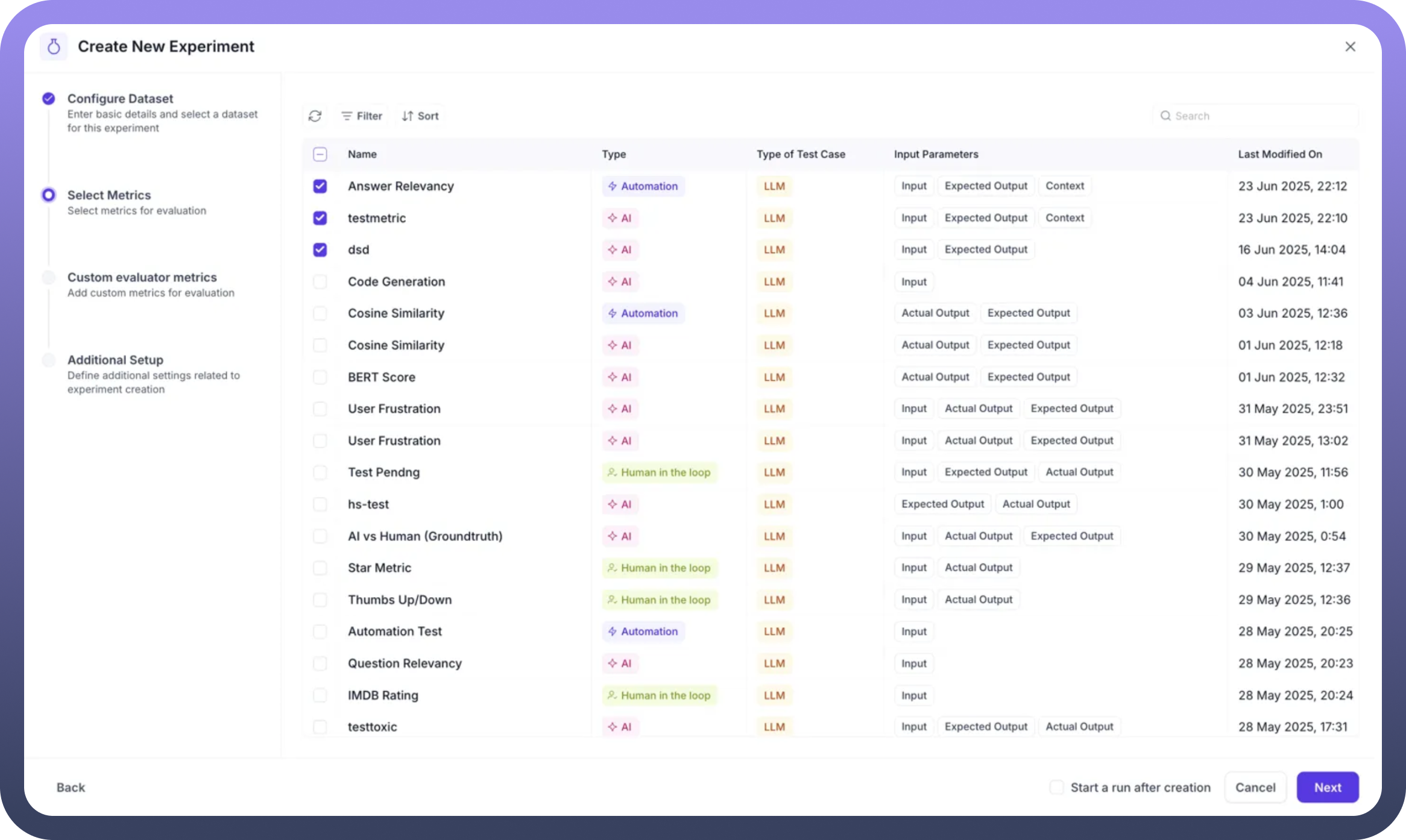
Step 2: Select Dataset and Output Source
Choose Your Dataset:
Select from your created datasets using the dropdown
The dataset provides the input test cases for evaluation
Define Output Source: Choose where the system should obtain outputs for evaluation:
Agent: The standard method for evaluating a specific AI AgentInputs from your dataset are sent to the selected agent
The agent's responses become the outputs for metric evaluation
Best for testing live agent performance
Task: Use an automation workflow as the evaluation targetSelect from your task automation interfaces
Choose the specific version to test
Useful for testing workflow-based implementations
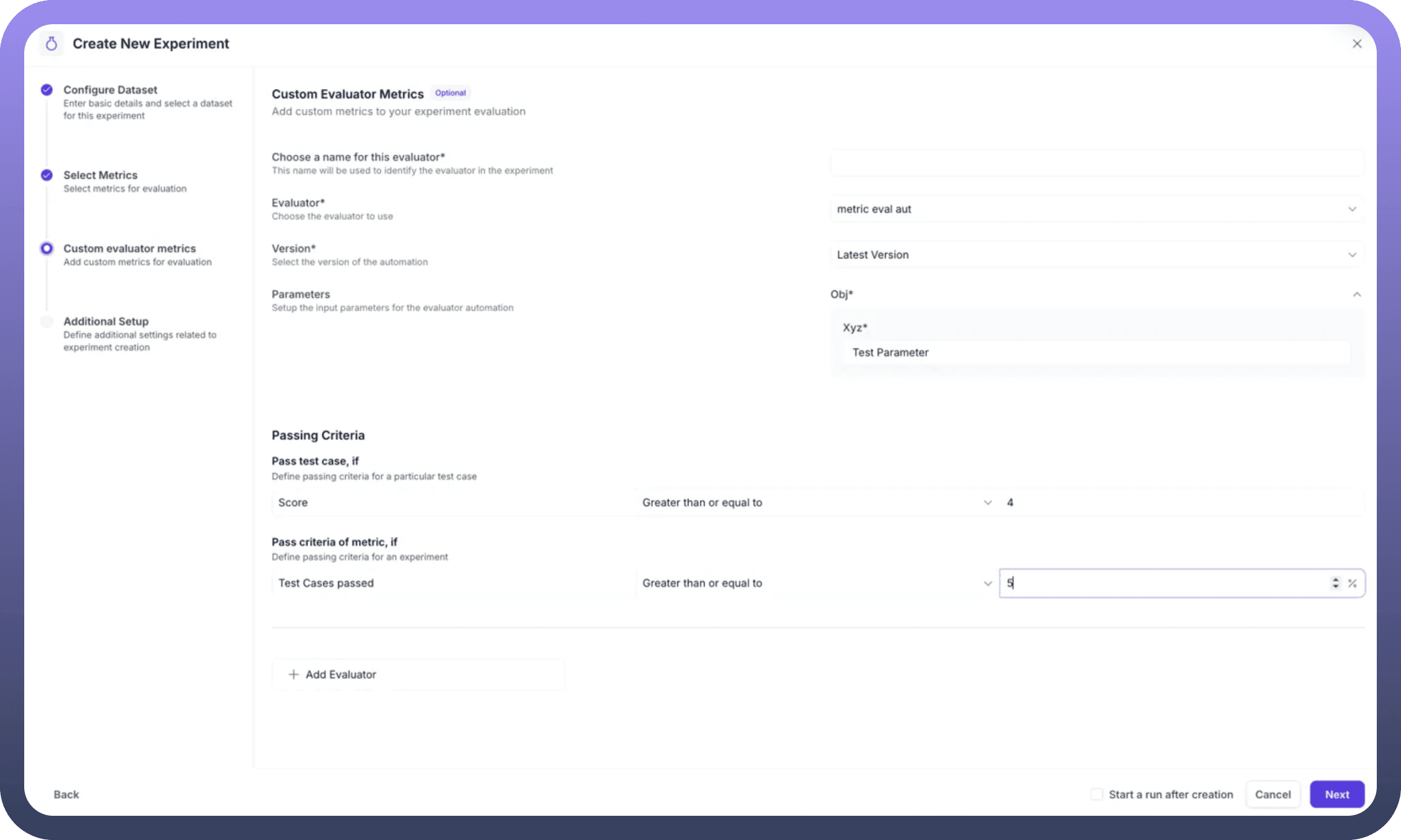
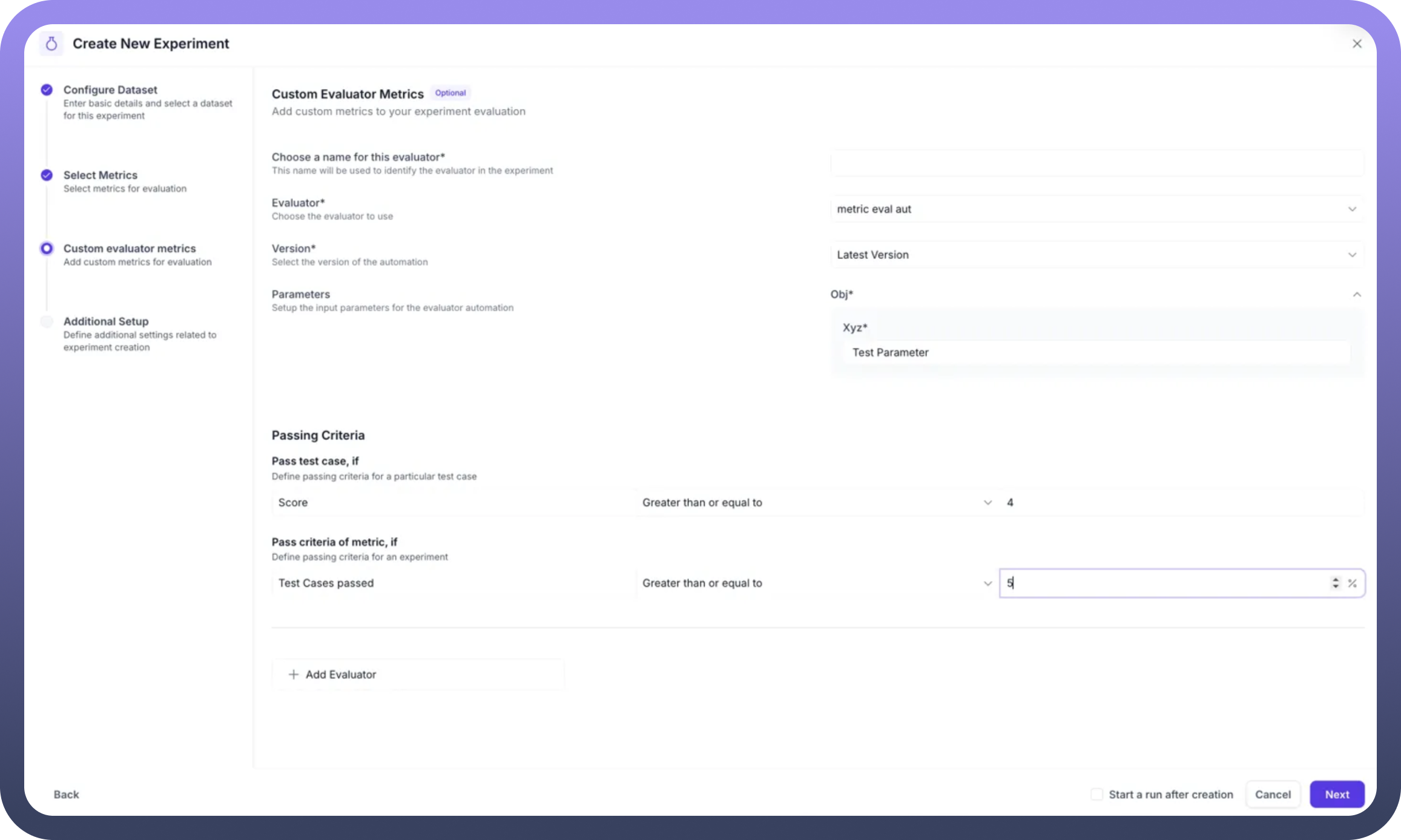
Step 3: Select Evaluation Metrics
The metrics selection screen displays all available metrics with detailed information:
Metric Name: Identifies each evaluation criterionType: Shows if it's AI-based or Automation-basedTest Case Type: Indicates LLM or Conversational evaluationInput Parameters: Lists required data points for each metric
Select relevant metrics by checking the boxes next to:
Answer Relevancy
testmetric
Code Generation
Cosine Similarity
User Frustration
And any other configured metrics
You can filter metrics using:
Search functionality
Type filters (AI, Automation, Human in the loop)
Sort options for easier navigation
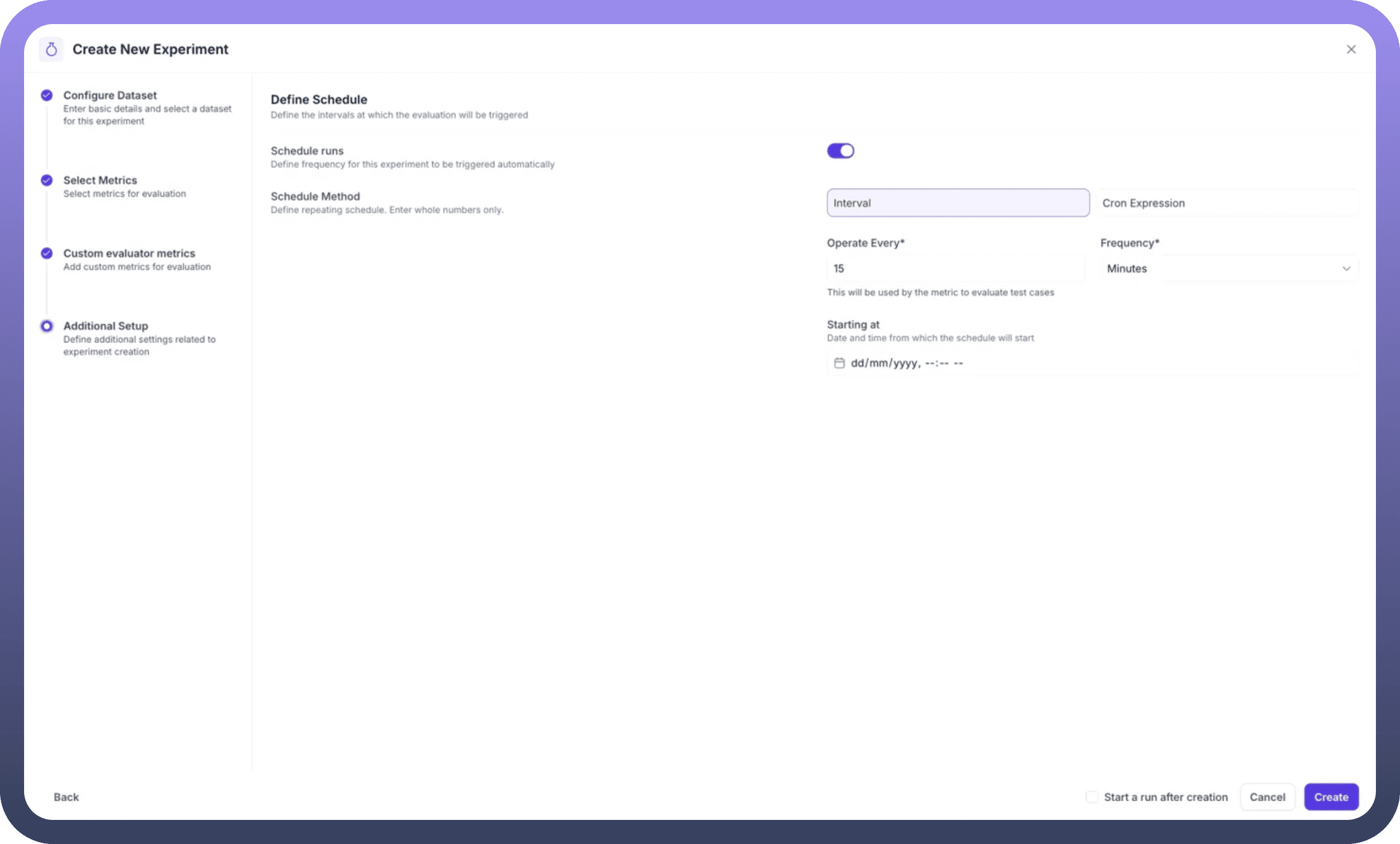
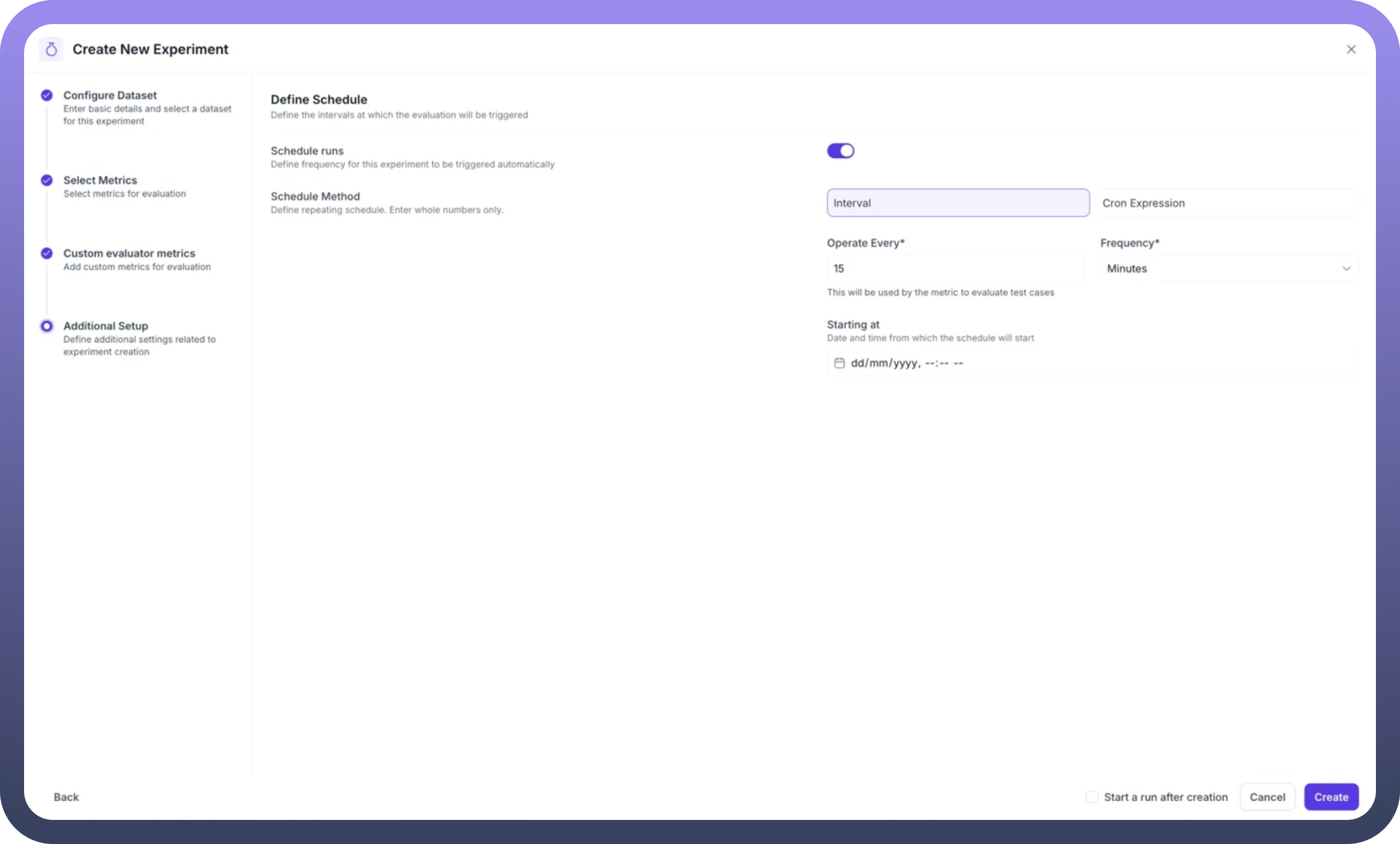
Step 4: Configure Custom Evaluator Metrics
This section allows you to add specialized evaluation logic:
Custom Evaluator Configuration:
Name: Identify the custom evaluatorEvaluator Selection: Choose from available automation evaluators (e.g., "metric eval aut")Version: Select the specific version to useParameters: Map input parameters to evaluator requirements
Passing Criteria Definition:
Test Case Level: Set score thresholds (e.g., Score ≥ 4)Experiment Level: Define overall success criteria (e.g., 75% test cases must pass)
Step 5: Scheduling
Configure automated experiment runs for continuous monitoring:
Schedule Configuration:
Toggle Schedule Runs: Enable/disable automated executionSchedule Method: Choose between Interval or Cron ExpressionFrequency Settings:Operate Every: Set interval value (e.g. 15)Frequency: Select time unit (Minutes, Hours, Days, etc.)
Starting Time: Define when the schedule begins
For advanced scheduling, use Cron expressions for precise control over execution timing.
Step 6: Create and Launch
Review your configuration and click Create to initialize the experiment. You'll be directed to the experiment dashboard where you can:
View experiment details
See selected dataset and metrics
Monitor scheduling status
Start your first evaluation run
Running Your Experiment
Once created, initiate your experiment evaluation:
Start New Run: Click the "
Start Run" button to begin evaluationMonitor Progress: Track the evaluation status as it processes test cases
View Results: Access detailed results once the run completes
Working with Task-Based Evaluations
When using Task automations instead of Agents:
Create Evaluation Automation: Build an automation using the "
Eval by UnifyApps" triggerConfigure Task Execution:
Map input parameters (input, expected output, context)
Define output generation logic
Return required fields (actual output, retrieved context, tools called)
Select in Experiment: Choose your task automation when configuring output source
Version Control: Select the appropriate automation version for testing
Human Annotation in Experiments
While automated metrics provide objective measurements, human annotation adds crucial qualitative assessment to your evaluation process. The platform seamlessly integrates human review capabilities within the experiment framework.
Understanding Human-in-the-Loop Metrics
Human annotation metrics appear with special indicators in the metrics list:
Marked with
Human in the looptagsRequire manual review of outputs
Provide subjective quality assessment
Complement automated evaluations
Accessing Experiment Results for Review
After an experiment run completes:
Navigate to Results: Access the detailed experiment results page
View Test Cases: Each test case displays:
Input query
Expected output
Actual agent response
Metric scores and pass/fail status
Reviewing Individual Test Cases
For each test case requiring human review:
Visible Information:
User input and expected output comparison
Automated metric scores (e.g.
Correctness of Output: Score 3)LLM judge reasoning and evaluation
Understanding Evaluation Results
The results interface provides comprehensive insights:
Metric Performance:
Individual scores for each metric
Pass/fail status based on defined thresholds
Detailed reasoning for each evaluation
Human Annotation Process
When reviewing results:
Examine Context: Review all available information including hidden fields
Assess Quality: Evaluate aspects automated metrics might miss
Document Findings: Note patterns or issues for improvement
Export Reports: Generate comprehensive evaluation reports
Best Practices for Experiments
Experiment Design:
Start with focused datasets testing specific capabilities
Combine complementary metrics for comprehensive evaluation
Include both automated and human review metrics
Schedule regular experiments to track performance trends
Output Source Selection:
Use Agent evaluation for production testing
Leverage Task evaluation for workflow validation
Consider version control when testing automations
Metric Selection Strategy:
Balance efficiency and thoroughness
Include metrics covering different aspects (accuracy, relevance, tool usage)
Add human review for nuanced assessment
Scheduling Considerations:
Run experiments during low-traffic periods
Set appropriate intervals based on change frequency
Monitor scheduled run results regularly
Troubleshooting Common Issues
System Limitations:
Check API access and authentication
Verify callback URLs are accessible
Ensure sufficient rate limits
Failed Metrics:
Review metric configuration
Validate input parameter mapping
Check automation logic for custom evaluators
Performance Optimization:
Limit concurrent test cases for resource-intensive evaluations
Use appropriate metric combinations
Consider batch processing for large datasets
By leveraging UnifyApps' experiment framework, you create a robust evaluation system that combines automated metrics with human insight. This comprehensive approach ensures your AI Agents meet quality standards while continuously improving based on systematic testing and feedback.